Commodore Amiga
| This article requires additional photographic illustration |
 | |
| Former type | Subsidiary |
|---|---|
| Industry | Computer hardware |
| Founded | 1985 |
| Defunct | 1994 |
| Headquarters | West Chester, PA, United States |
| Key people |
Irving Gould (Chairman), Mehdi Ali (President) |
| Parent | Commodore Business Machines |
The Commodore Amiga is a computing platform, introduced by Commodore in 1985 after it had purchased Amiga Inc.
The classic Amiga used the Motorola MC680x0 family of processors and a custom chip set which gave it good graphics and sound capabilities (for the time) at a low cost. Its proprietary operating system had a windowing system and was one of the first for home computers to have preemptive multitasking. It was considered before its time when it arrived but much behind when Commodore folded in 1994.
The platform still has a small but very dedicated user community which has produced different expansions, emulators and follow-up systems. This is an input device wiki, so the focus of this article is on Amiga keyboards and mice.
Contents
Common features of Amiga keyboards
- What makes the Amiga keyboard layout stand out the most are the two Amiga keys at each end of the space bar. The right is used for command shortcuts and the left for the windowing-system.
- ANSI Amiga keyboards have a backwards-L ("Big-Ass") Return key where as ISO keyboards have a vertical Return key. Compared to PC keyboards, ISO has not one but two additional keys: one next to left Shift and one next to a vertical Return key. All variations have a small Backspace key.
- The layout has both a Ctrl key and a Caps Lock key to the left of 'A' on the home row. Unlike the PC the (only) Ctrl key is seldom used in GUI based programs and is used mainly in terminal emulators, the command console and Micro Emacs which was included.
- The Caps Lock key has a LED in it to indicate Caps mode. This is the only keyboard LED. On computers with LEDs in the top/right corner or on the right near the keyboard, those LEDs are actually for power and FDD and (on Amiga 600 and 1200) HDD activity, and are on separate circuits.
- There are Cursor keys, with Del and Help keys above them. Shift+cursor is used to move the cursor to beginning of line, end of line, page up and page down, so special navigation keys for those tasks are not needed. Text selection using the keyboard is typically modal, initiated with the key combination Amiga-B and ended with Amiga-X (Cut) or Amiga-C (Copy).
- There are two Alt keys, both functioning as second-level Shift (like the Alt Gr key on PC, or the Option key on Macintosh), on the bottom left and bottom right corners of the main typing area.
- Esc key and ten function keys.
- All Amiga keyboards except the one in the Amiga 600 have a numeric keypad. Starting with the Amiga 2000, the numpad also has +, *, /, as well as left and right brackets. The added keys, different layout and side printed legends make it more compatible with the layout in the common IBM Enhanced Keyboard, which was relevant for PC emulation.
- Only Cherry-made Amiga 2000 keyboards have diodes for N-key rollover. The others have the same keyboard matrix, published in the Amiga Hardware Reference Manual so that software developers would be able to design around blocking key combinations.[1] (The seven modifier keys are outside the matrix, each with a dedicated line).
Form factor and design
Models with integrated keyboards have it placed above the logic board as was common with home computers at the time. Whereas most external Amiga keyboards have tactile feel, most integrated Amiga keyboards have linear feel. The exceptions are the Cherry-made versions that instead have linear Cherry MX Black.
Amiga 500 keyboards have Power and FDD activity LEDs on a circuit board together with the keyboard controller in the keyboard assembly. Inside the Amiga 600 and 1200, the controller is instead on the main logic-board and Power, FDD and HD activity LEDs are on a separate board.
All Commodore Amiga keyboards use the same serial protocol, but there are a few different connectors.
- Amiga 1000 has a 4P4C modular connector.
- Amiga 2000, 3000 and Amiga 4000T keyboards use a 5-pin DIN-plug.
- Desktop Amiga 4000 has a 6-pin mini-DIN plug. The DIN and Amiga 4000 mini-DIN pin assignments are the same as for AT and PS/2, so any passive adaptor between AT and PS/2 should work as adaptor.
- Commodore CDTV keyboards have a 5-pin mini-DIN, not compatible with the Amiga 4000.
- The Amiga 500 has a cable connected to the motherboard and can be adapted or rebuilt to use an external keyboard.
- The Amiga 1200 and 600 have serial communication only between components on the motherboard so any adapter would have to be a controller or emulate a matrix, respectively.
Keyboards
| Photo | Name | Form factor | Notes |
|---|---|---|---|
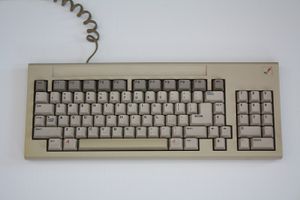
|
Amiga 1000 | External | The first Amiga's keyboard is significantly different than those of later Amiga models. The cursor keys are in a star configuration (instead of "inverse-T"), there are homing bumps on the D and K keys (instead of dished F and J keys), and the numeric keypad is smaller.
|
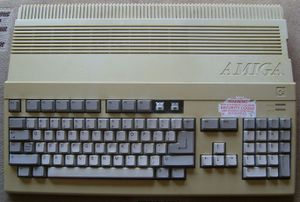
|
Amiga 500(+) | Integrated | Like the Amiga 2000, the Amiga 500 has also come in multiple revisions.
|
| Amiga 600 | Integrated | More compact layout that omitted the numeric keypad. The cursor keys and the Help and Del keys have moved left and the Esc key is 1.25 units wide.
| |

|
Amiga 2000 | External | Three variants have been identified:
|
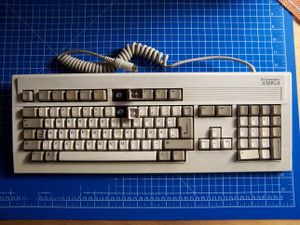
|
Amiga 3000(T) | External | Linear KPR no sleeves, spring only or Tactile KPQ type Mitsumi hybrid switches with rubber sleeves under the keycaps. The keyboard case had been updated with stripes on top reminding of the cooling vents on the Amiga 500.
|
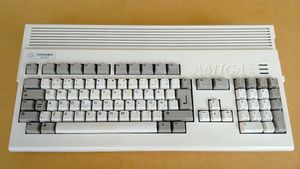
|
Amiga 1200 | Integrated | Linear KPR type Mitsumi hybrid switches with coiled springs under the keycaps. The membrane extends as a ribbon cable to a connector on the main logic board where the controller is located. |
| Amiga 4000 (desktop) | External | Similar to the Amiga 3000 keyboard. The case is white (not beige) and has (yet) another connector.
| |
| Amiga 4000T (tower) | External | The Amiga 4000T returns to the same DIN-plug as for the Amiga 2000.
| |
| Amiga 1500, Amiga 2500 | External | Late variations of the Amiga 2000. | |
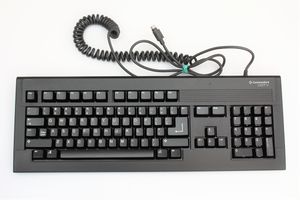
|
CDTV | External | Basically a black version of the Amiga 3000 keyboard, but with a mini-DIN connector using a custom pinout. |
| Amiga CD32 | External | Anthracite case and keys with black modifiers, plus the "Amiga CD32" logo.[4]
|
Replacement keyboards
See individual pages for Amiga 500, 600 and 1200.
Conversion kits
It was not unusual to convert an Amiga 500 into a desktop or tower form factor with external keyboard. The keyboard had a serial cable to header pins on the motherboard making this possible. Several kits were made and sold for this purpose.
The Checkmate A1500 was one such conversion kit sold in the UK. Commodore released the Amiga 1500 to prevent the cheaper Amiga 500 with Checkmate's kit from taking sales from the Amiga 2000. In 2019, Checkmate released a follow-up: the Checkmate A1500 plus, with an option for an external keyboard case in sheet metal.
The Infinitiv kit from Micronik, converts instead an Amiga 1200 into a minitower system with an external keyboard enclosure.
Other Amiga keyboards
The AmigaOne platform supports common PS/2 keyboards and mice.
Keyboard adapters
Other keyboard to Amiga
- The Lyra is a converter that allows a PS/2 keyboard to be connected to an Amiga. There is a version for the Amiga 1200 and a version for Amiga 2000/3000/4000/CDTV/CD32.
- The PC-Key is an interface device for the Amiga 1200 and 600, allowing them to use an external Amiga keyboard or a PS/2 keyboard.
- The Sum adapter enables connecting a USB HID keyboard to the Amiga 1200.
Amiga keyboards to USB
The options below require more or less hacking.
- The Keyrah is a controller that replaces the motherboard in the Amiga 600 and 1200 (also the Vic 20, Vic 64 and 128). It has two digital joystick ports and USB out. Joysticks are emulated as key presses.
- Tynemouth Software has different adapter boards for installation into Amiga 1200/600 and 500 enclosures.
- AMIGA 500/1000/2000 Keyboard Interface. Firmware for an Arduino Leonardo, allowing an external Amiga keyboard to be connected via USB to a modern computer.
- EzHID Amiga Keyboard Firmware for the Cypress' EZ-USB (AN2131) chip. The firmware has support for other input devices.
Controller ports
All Amiga models came with two Commodore 64-compatible DE-9 controller ports. In addition to support for light pen and various game controllers, there was also dedicated hardware for a bus mouse in each port.
A two-button ball mouse was included as standard with every Amiga running AmigaOS, for its graphical user interface. Amiga Unix, the Amiga 3000UX mouse and some third-party mice used a third mouse button. A second Amiga mouse is used only in some two-player games, but the second port's circuitry could also be used for rotary controllers such as steering wheels.
Mouse usage
If the right mouse button is pressed a menu bar appears at the top of the screen. A menu item is selected by releasing the right button when hovering the pointer above it. Releasing the mouse button elsewhere cancels.
Third-party utilities were available that replaced (or complimented) the menu bar with a pop-up menu underneath the mouse pointer.
After having booted into AmigaOS, it supported mouse keys as combinations with the two Amiga keys.
Aftermarket mice in the late '90s added a scroll wheel and up to three more buttons.
Mouse models
The "Tank mice" for the Amiga have an angular exterior similar to the Commodore 1350 and 1351 "tank mice" for the Commodore 64, but they differ in their signals. All Amiga mice are bus mice.
- Tank mouse with angled connector only for the Amiga 1000.[5]
- Tank mouse (Amiga 500, 2000). "1352".
- Tank mouse version 2: "313254-01"
- Amiga 3000 "pregnant" mouse. Ridge at edges between buttons. The ball is in the middle.[6]
- Amiga 3000 UX mouse. This has three buttons for use with Amiga Unix.[6]
- Wireless infrared CDTV mouse. "CD 1252".[7]
- Wired CDTV mouse, 1253. Apparently inspired by the 1987 Microsoft mouse: the ball has moved forward and the buttons are larger.[7]. Narrower in front and the left button is wider than the right.
- Amiga 600/1200/4000 mouse. Similar to 1253 but off-white like the computers it was bundled with.
- Amiga 600 mouse. Both buttons are the same size. Ball forward.
- Amiga CD32 mouse. Like the 1253 but grey and the Amiga CD³² logo printed on top.
- Amiga Technologies Mouse. A different design branded by Amiga Technologies who had bought Commodore assets after Commodore had folded. Narrow in the middle with a dimple in the left button, and the new "Amiga" logo printed on it.
Retro mice
TheA500 Mini from Retro Games Ltd in the UK is an upcoming "mini retro console" resembling the Amiga 500. It comes with a matching "Tank" mouse that talks USB[8] but it is smaller than the original. The mouse is also available to order separately.
There exist optical kits for the "tank" mouse, but those remain bus mice for genuine Amiga computers.
See also
- Atari interface — Every Amiga had two of these Controller ports for mouse and joystick/s.
- Atari ST — This computer was the Amiga's biggest competitor at the time.
References
- ↑ AmigaOS 3.5 Developer Docs — Amiga Hardware Reference Manual: Interface hardware: The Keyboard: Limitations of the Keyboard. Retrieved 2018-04-18.
- ↑ Amibay — Help Key and white "space invaders" switch
- ↑ 3.0 3.1 Amiga Keyboard Pinouts on l8r.net. Retrieved on 2018-01-04
- ↑ Amiga.org — Is there a genuine CD32 keyboard?
- ↑ Ramond de Vrede's retro collection: Commodore Amiga 1000 Mouse. Retrieved 2022-10-19.
- ↑ 6.0 6.1 Zimmers.net—Commodore/Amiga A3000 "Pregnant" Mice. Retrieved 2018-07-13
- ↑ 7.0 7.1 Zimmers.net—Commodore 1252 & 1253 Mice. Retrieved 2018-07-13
- ↑ Retro Games Ltd—The A500 MINI. Retrieved 2021-09-19